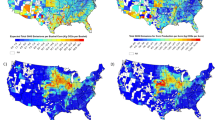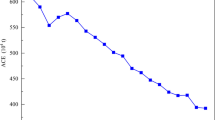Abstract
Purpose
Rising corn prices in the USA due partly to increasing ethanol demands have led to a significant expansion of corn areas displacing natural vegetation and crops including cotton. From 2005 to 2009, cotton area harvested in the USA nearly halved with a reduction of 2.5 million hectares, while that of corn increased by 1.8 million hectares. However, environmental impacts of land shifts from cotton and corn have been largely neglected in literature.
Methods
In this study, we evaluate the environmental properties of US corn and cotton production and implications of land cover change from cotton to corn using state-specific data and life cycle impact assessment. Focusing on regional environmental issues, we cover both on-farm direct emissions such as different types of volatile organic compounds and pesticides and indirect emissions embodied in input materials such as fertilizers. TRACI 2.0 is used to evaluate the environmental impacts of these emissions.
Results and discussion
The results show that US cotton and corn productions per hectare on average generate roughly similar impacts for most impact categories such as eutrophication and smog formation. For water use and freshwater ecotoxicity, corn shows a smaller impact. When land shifts from cotton to corn in cotton-growing states, however, the process may aggravate most of the regional environmental impacts while relieving freshwater ecotoxicity impact. The differences in the two estimates are due mainly to underlying regional disparities in crop suitability that affects input structure and environmental emissions.
Conclusions
Our results highlight the importance of potential, unintended environmental impacts that cannot be adequately captured when average data are employed. Understanding the actual mechanisms under which certain policy induces marginal changes at a regional and local level is crucial for evaluating its net impact. Further, our study calls for an attention to biofuel-induced land cover change between crops and associated regional environmental impacts.


Similar content being viewed by others
References
Andrade de Sá S, Palmer C, Di Falco S (2013) Dynamics of indirect land-use change: empirical evidence from Brazil. J Environ Econ Manag 65:377–393
Arima EY, Richards P, Walker R, Caldas MM (2011) Statistical confirmation of indirect land use change in the Brazilian Amazon. Environ Res Lett 6:024010
Babcock B (2009) Measuring unmeasurable land-use changes from biofuels. Iowa Ag Rev 15:3
Bare J (2011) TRACI 2.0: the tool for the reduction and assessment of chemical and other environmental impacts 2.0. Clean Technol Environ Policy 13:687–696. doi:10.1007/s10098-010-0338-9
Bare J, Norris G, Pennington D, McKone T (2003) The tool for the reduction and assessment of chemical and other environmental impacts. J Ind Ecol 6:49–78
Berthoud A, Maupu P, Huet C, Poupart A (2011) Assessing freshwater ecotoxicity of agricultural products in life cycle assessment (LCA): a case study of wheat using French agricultural practices databases and USEtox model. Int J Life Cycle Assess 16:841–847
Brandão M, Clift R, Cowie A, Greenhalgh S (2014) The use of life cycle assessment in the support of robust (climate) policy making: comment on “Using Attributional Life Cycle Assessment to Estimate Climate-Change Mitigation”. J Ind Ecol 18:461–463
Chiu Y, Walseth B, Suh S (2009) Water embodied in bioethanol in the United States. Environ Sci Technol 43:2688–2692
Claassen R, Carriazo F, Cooper JC et al (2011) Grassland to cropland conversion in the Northern Plains. Economic Research Service, U.S. Department of Agriculture, Washington DC
Dale BE, Kim S (2014) Can the predictions of consequential life cycle assessment be tested in the real world? comment on “Using Attributional Life Cycle Assessment to Estimate Climate-Change Mitigation”. J Ind Ecol 18:466–467
Ecoinvent (2014) Database. In: Ecoinvent Database V22. http://www.ecoinvent.org/database
EPA (1999) Background report on fertilizer use, contaminants and regulations. National Program Chemicals Division, Office of Pollution Provention and Toxics, U.S. Environmental protection Agency, Colombus, OH, USA
EPA (1995) Emissions Factors & AP 42, Compilation of Air Pollutant Emission Factors, Chapter 9: Food and Agricultural Industries. United States Environmental Protection Agency, Washington, DC, USA
Fanin JM, Paxon KM, Barreca JD (2008) Evaluating the Shift from Cotton to Corn: Impacts on the Louisiana Economy. Agricultural Center, Louisiana State University, Baton Rouge LA
Fargione J, Hill J, Tilman D et al (2008) Land clearing and the biofuel carbon debt. Science 319:1235–1238
Gelfand I, Zenone T, Jasrotia P et al (2011) Carbon debt of conservation reserve program (CRP) grasslands converted to bioenergy production. Proc Natl Acad Sci U S A 108:13864–13869
Goebes MD, Strader R, Davidson C (2003) An ammonia emission inventory for fertilizer application in the United States. Atmos Environ 37:2539–2550
Goedkoop MJ, Heijungs R, Huijbregts M et al (2009) ReCiPe 2008, A life cycle impact assessment method which comprises harmonised category indicators at the midpoint and the endpoint level; First edition Report I: Characterization. http://www.lcia-recipe.net/
Guinee JB, Gorree M, Heijungs R et al (2002) Handbook on life cycle assessment: operational guide to the ISO standards. Kluwer Academic Pubisher, Dordrecht, the Netherlands
Herner AE (1992) The USDA-ARS pesticide properties database: a consensus data set for modelers. Weed Technol 6:749–752
Hertel TW, Golub AA, Jones AD et al (2010) Effects of US maize ethanol on global land use and greenhouse gas emissions: estimating market-mediated responses. Bioscience 60:223–231
Hertwich E (2014) Understanding the climate mitigation benefits of product systems: comment on “Using Attributional Life Cycle Assessment to Estimate Climate-Change Mitigation”. J Ind Ecol 18:464–465
Hill J, Nelson E, Tilman D et al (2006) Environmental, economic, and energetic costs and benefits of biodiesel and ethanol biofuels. Proc Natl Acad Sci U S A 103:11206–11210
Hill J, Polasky S, Nelson E et al (2009) Climate change and health costs of air emissions from biofuels and gasoline. Proc Natl Acad Sci U S A 106:2077–2082
ISO (2006) ISO 14042, environmental management-life cycle assessment-life cycle impact assessment. International Organization for Standardization, Geneve
Jackson RB, Jobbágy EG, Avissar R et al (2005) Trading water for carbon with biological carbon sequestration. Science 310:1944–1947
Keeney D (2008) Ethanol USA. Environ Sci Technol 43:8–11
Keeney R (2010) Yield response and biofuels: issues and evidence on the extensive margin. World Congress of Environmental and Resource Economists
Krauter C, Goorahoo D, Potter C, Klooster S (2002) Ammonia emissions and fertilizer applications in California’ s Central Valley
Liska A, Yang H, Bremer V et al (2009) Improvements in life cycle energy efficiency and greenhouse gas emissions of corn ethanol. J Ind Ecol 13:58–74
Malcolm S, Claassen R, Nickerson C (2009) Ethanol and a changing agricultural landscape. Economic Research Service, US Department of Agriculture, Washington, DC, USA
Mathiesen BV, Münster M, Fruergaard T (2009) Uncertainties related to the identification of the marginal energy technology in consequential life cycle assessments. J Clean Prod 17:1331–1338
Miller S, Landis A, Theis T (2006) Use of Monte Carlo analysis to characterize nitrogen fluxes in agroecosystems. Environ Sci Technol 40:2324–2332
Mortvedt J (1995) Heavy metal contaminants in inorganic and organic fertilizers. Nutr Cycl Agroecosyst 43:55–61
Plevin RJ, Delucchi MA, Creutzig F (2014) Using attributional life cycle assessment to estimate climate-change mitigation benefits misleads policy makers. J Ind Ecol 18:73–83
Plevin R, Jones A, Torn M, Gibbs H (2010) Greenhouse gas emissions from biofuels’ indirect land use change are uncertain but may be much greater than previously estimated. Environ Sci Technol 44:8015–8021
RFA (2013) Industry Statistics. http://www.ethanolrfa.org/pages/statistics. Accessed 18 Dec 2013
Rosenbaum RK, Bachmann TM, Gold LS et al (2008) USEtox—the UNEP-SETAC toxicity model: recommended characterisation factors for human toxicity and freshwater ecotoxicity in life cycle impact assessment. Int J Life Cycle Assess 13:532–546
Runge F, Johnson R (2008) The browning of biofuels: environment and food security at risk. Woodrow Wilson International Center for Scholars, Washington, DC, USA
Sanchez ST, Woods J, Akhurst M et al (2012) Accounting for indirect land-use change in the life cycle assessment of biofuel supply chains. J R Soc Interface R Soc 9:1105–1119
Searchinger T, Heimlich R, Houghton R et al (2008) Use of US croplands for biofuels increases greenhouse gases through emissions from land-use change. Science 319:1238–1240
Secchi S, Gassman PW, Jha M et al (2010) Potential water quality changes due to corn expansion in the Upper Mississippi River Basin. Ecol Appl 21:1068–1084
Shapouri H, Gallagher PW, Nefstead W et al (2010) 2008 Energy balance for the corn-ethanol industry. U.S. Department of Agriculture, Washington, DC, USA
Schmidt JH, Weidema BP (2008) Shift in the marginal supply of vegetable oil. Int J Life Cycle Assess 13:235–239
Socolow RH (1999) Nitrogen management and the future of food: lessons from the management of energy and carbon. Proc Natl Acad Sci U S A 96:6001–6008
Suh S, Yang Y (2014) On the uncanny capabilities of consequential LCA. Int J Life Cycle Assess 19:1179–1184
Tessum CW, Marshall JD, Hill JD (2012) A spatially and temporally explicit life cycle inventory of air pollutants from gasoline and ethanol in the United States. Environ Sci Technol 46(20):11408–11417
Tsao C-C, Campbell JE, Mena-Carrasco M et al (2012) Biofuels that cause land-use change may have much larger non-GHG air quality emissions than fossil fuels. Environ Sci Technol 46:10835–10841
USDA (2014a) Cropland data layer metadata. http://www.nass.usda.gov/research/Cropland/SARS1a.htm. Accessed 13 Mar 2014
USDA (2014b) Quick Stats. http://www.nass.usda.gov/Quick_Stats/. Accessed 13 Mar 2014
USDA (2004) Energy use on major field crops in surveyed states. Economic Research Service, US Department of Agriculture, Washington, DC, USA
USDA (2014c) Farm and Ranch Irrigation Survey 2008 and 2003. http://www.agcensus.usda.gov/Publications/2007/Online_Highlights/Farm_and_Ranch_Irrigation_Survey/index.php. Accessed 13 Mar 2014
USDA (2006) Model simulation of soil loss, nutrient loss, and change in soil organic carbon associated with crop production. Natural Resource Concervation Service, US Department of Agriculture, USA
USDA (2000) Environmental indicators of pesticides leaching and runoff from farm fields. Natural Resource Conservation Service, US Department of Agriculture, USA
Wallander S, Claassen R, Nickerson C (2011) The ethanol decade: an expansion of US corn production, 2000-09. US Department of Agriculture, Economic Research Service, Washington, DC, USA
Wang M (2013) The Greenhouse Gases, Regulated Emissions, and Energy Use in Transportation (GREET) Model, 2012
Wang MQ, Han J, Haq Z et al (2011) Energy and greenhouse gas emission effects of corn and cellulosic ethanol with technology improvements and land use changes. Biomass Bioenergy 35:1885–1896
Weidema BP, Frees N, Nielsen AM (1999) Marginal production technologies for life cycle inventories. Int J Life Cycle Assess 4:48–56
Wright CK, Wimberly MC (2013) Recent land use change in the Western Corn Belt threatens grasslands and wetlands. Proc Natl Acad Sci U S A 110:4134–4139
Yang Y (2013) Life cycle freshwater ecotoxicity, human health cancer, and noncancer impacts of corn ethanol and gasoline in the US. J Clean Prod 53:149–157
Yang Y, Bae J, Kim J, Suh S (2012) Replacing gasoline with corn ethanol results in significant environmental problem-shifting. Environ Sci Technol 46:3671–3678
Yienger JJ, Levy H (1995) Empirical model of global soil-biogenic NOχ emissions 1984–2012. J Geophys Res Atmospheres 100:11447–11464
Author information
Authors and Affiliations
Corresponding author
Additional information
Responsible editor: Greg Thoma
Electronic supplementary material
Below is the link to the electronic supplementary material.
ESM 1
(DOCX 2305 kb)
Rights and permissions
About this article
Cite this article
Yang, Y., Suh, S. Land cover change from cotton to corn in the USA relieves freshwater ecotoxicity impact but may aggravate other regional environmental impacts. Int J Life Cycle Assess 20, 196–203 (2015). https://doi.org/10.1007/s11367-014-0817-z
Received:
Accepted:
Published:
Issue Date:
DOI: https://doi.org/10.1007/s11367-014-0817-z




